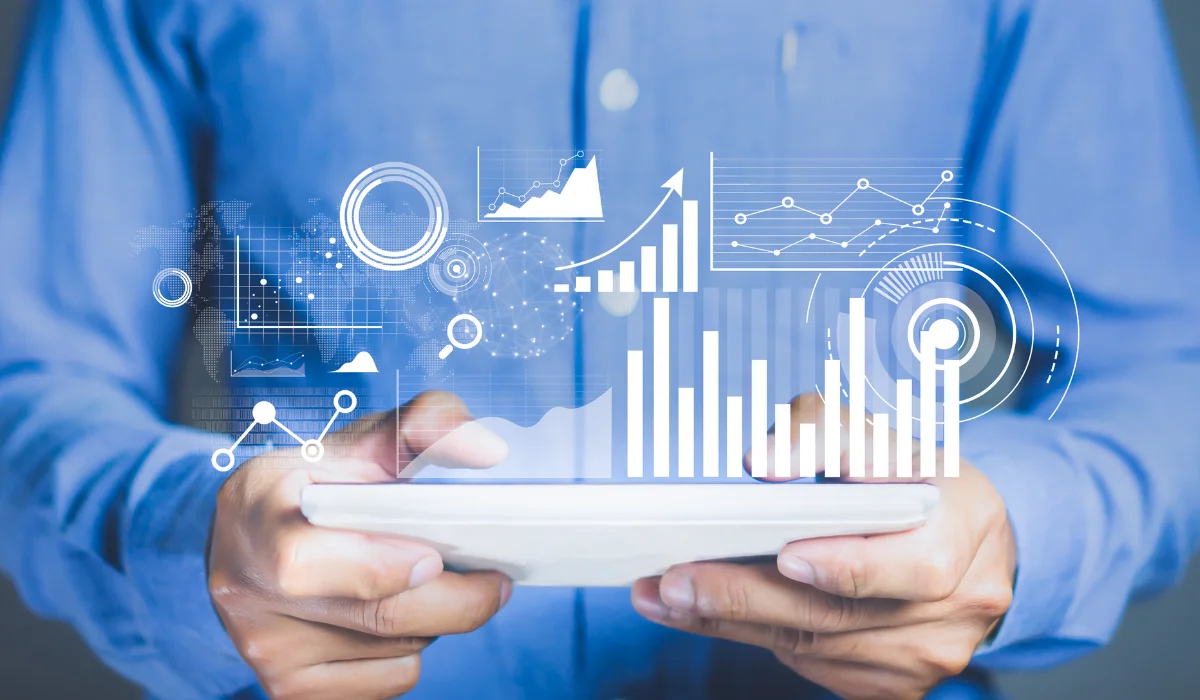AI in Action: 7 Examples of AI Changing Data Analytics
- SoftudeFebruary 24, 2025
- Last Modified onFebruary 24, 2025
Artificial intelligence has grown from a theoretical concept. Now, it is infused into companies' day-to-day operations, transforming how data is processed, analyzed, and utilized. In this blog, we examine seven real-world examples where AI has transformed data analytics. Each example discusses a particular use case, shows tangible results, and emphasizes lessons that can be translated into your data initiatives.

7 Examples Where Businesses Are Using AI in Data Analytics
1. Improved Customer Segmentation

Companies used to base their understanding of customers on simple demographics. Today, AI platforms scan enormous data sets from purchase history and social media activity to define sophisticated customer segments. Retailers can abandon mass-market marketing campaigns, instead use clustering algorithms to discover latent patterns in customer behavior, segmenting shoppers by age or geography, subtle interests, and purchase drivers.
One real-life use case is where our client wanted to understand the common issues their customers were facing and how likely they would recommend their products.
We clustered different responses from social media platforms and analyzed the sentiments of customers. The result? Our client discovered areas to improve the quality of existing products, positive customer experience, and increase in positive brand impressions.
2. Fraud Detection in Finance

Fraud detection has never been a cat-and-mouse. Old systems couldn't cope with the volume and sophistication of today's financial transactions. Step forward AI. Machine learning algorithms constantly monitor transactions for anomalies, comparing live data to historical behaviors. These algorithms identify deviations that can indicate fraud, even if such indicators are faint or developing.
For example, a well-known bank incorporated an AI-driven fraud detection system into its processes. Within a few months, the system highlighted suspicious transactions that evaded traditional checks. The proactive step resulted in a 30% drop in fraud cases.
The AI model updated its detection parameters from every event highlighted, and thus, it continued to improve continuously. The result was a decline in fraudulent losses and enhanced customer trust, which felt that a learning system was actively safeguarding their financial security.
3. Predictive Analytics in Healthcare

The healthcare industry is rife with uncertainties. Patient outcomes, admissions, and disease outbreaks are all predictable and can make a big difference to the treatment process and resource management. AI-powered predictive analytics are coming in to provide a clearer vision of the future. These systems predict events more accurately by crunching historical patient information and prevalent health trends.
For instance, one regional hospital implemented an AI program forecasting patient admissions. The system reviewed historical admission volumes, seasonal sicknesses, and minor events that could affect traffic to the hospital.
Consequently, the hospital could pre-adjust staffing levels, lowering waiting times and giving patients timely care. Not only did the predictive capability improve operational effectiveness, but it also gave data-based evidence to gain additional investments in AI technology.
4. Retail Inventory Optimization

Inventory management has always been a retailer's headache. Stock-outs, overstock, and wasted assets frequently translate to lost sales. AI-powered optimization solution reviews sales patterns, externalities such as weather and local events, and history to predict demand with high precision.
One of the big retail chains developed an AI-based system that foresaw the right inventory levels for its different stores. The projections of the system were fed back into the supply chain, resulting in real-time changes. The effect was quick: a tremendous decrease in excess inventory and lost sales opportunities.
By aligning the amount of stock to actual demand with greater accuracy, the retailer minimized costs and enhanced customer satisfaction by ensuring that fast-moving items never ran out.
5. Predictive Maintenance in Manufacturing

Manufacturing operations are usually interrupted by surprise equipment breakdowns. The price of unexpected downtime can be staggering. Scheduled maintenance based on periodic inspections and predetermined intervals is no longer adequate. AI-based predictive maintenance rewrites the rule book by tracking equipment performance in real-time and predicting possible failures ahead of time.
One factory implemented sensors and AI software to monitor the operating parameters of its key machines. The software picked up on slight changes in vibration patterns and temperature levels, signs of impending wear.
The factory minimized downtime by almost 40% by performing maintenance before a breakdown. The technology saved on maintenance and increased the life of costly machinery, demonstrating that smart monitoring can be preventative and cost-saving.
6. Route Optimization in Logistics

Effective delivery is the foundation of logistics. Businesses constantly struggle with dynamic traffic patterns, weather conditions, and changing road conditions. Artificial intelligence has stepped in as an effective tool for route optimization. Through real-time data analysis, AI algorithms can suggest the best, most economical routes, even as conditions vary minute by minute.
One logistics firm incorporated an AI-driven logistics system that constantly evaluated traffic patterns, weather conditions, and delivery schedules. The system constantly adjusted routes, lessening fuel usage and shortening delivery times.
In one trial, delivery times were reduced by 15%, and fuel costs followed suit. The effectiveness of this system was that it could learn from past data and adjust its forecasts so that every delivery was as efficient as possible.
7. Talent Acquisition in Human Resources
The recruitment process has been work-intensive in the past, with resumes to go through in thousands and human impressions that might compromise objectivity. AI is revolutionizing employee hiring by qualifying resumes and foreseeing the future of the selected candidates using statistical data.
An international company set up an AI solution that would scan resumes, compare them against the job roles' specifications, and identify potential discrimination in the process. The system ranked candidates on various parameters, from technical competence to cultural alignment, and recommended the most suitable ones.
Not only did this accelerate the hiring process, but it also enhanced the quality of hires. The firm achieved a 20% decrease in time-to-hire and a significant increase in employee retention, highlighting the importance of incorporating AI into HR functions.
Benefits and Challenges
The above examples have one thing in common: AI introduces precision and velocity into data analysis. The benefits of AI in data science are many-sided. Financial returns, cost savings, and improved operating efficiencies are outright results of implementing AI solutions. More significantly, AI brings an element of adaptability and constant learning that legacy systems cannot compete with.
Challenges
However, implementing AI in data analytics also comes with issues. Data quality is still important, biased or incomplete data can alter AI results. Implementing AI in existing infrastructure can also pose challenges, meaning technical updates and behavioral changes in business organizations must be achieved. AI models must be re-tuned and re-verified continuously to keep their reliability in a very dynamic environment.
Future Trends in AI-Driven Data Analytics

Looking forward, the development of AI in data science is going to accelerate. New technologies like real-time data processing, data governance through AI, and self-learning algorithms will further revolutionize the process. The coupling with IoT devices can ensure an even higher amount of data, rendering the use of AI for sifting through and interpreting the data even more important than ever before.
Companies following these trends will be in good stead to realize the full power of AI in data analytics. They will streamline existing operations and open up new opportunities for expansion and innovation.
Conclusion
AI has ushered in the change through data analytics that is both deep and quantifiable. From optimizing customer segmentation to automating logistics and transforming the hiring process, AI has proven to be capable of making tangible gains. Examples of AI in data analytics mentioned here highlights a shared fact: data is a valuable resource when analyzed with intelligence.
For companies considering AI implementation, the way ahead is straightforward. Start with a careful assessment of your current data processes. Determine where AI can make evident improvements and launch pilot programs to dip one's toes. Gather data carefully, learn from the results, and expand successful programs.
The trip can be tough, especially when new technology is brought into existing systems. But the payoff-cost, better performance, and competitive edge-is well worth it. With AI developing further, so will its uses in data analysis, presenting new opportunities for those open to change.
By emphasizing actionable metrics and practical applications, companies can pierce the hype and unlock AI's potential for transformation. No matter which industry you belong to, AI provides tools that are not only new but also essential to the data-driven business of today.
Liked what you read?
Subscribe to our newsletter








.png)



